Law enforcement agencies often grapple with the decision to employ camouflage designs on their patrol vehicles. While these designs can be advantageous in certain tactical situations, they have also sparked debates about their appropriateness in serving and protecting the community. In this article, we will delve into the pros and cons of camouflage in law enforcement and explore the importance of finding the right balance between functionality and public perception.

The Role of Camouflage in Law Enforcement
Camouflage patterns are widely recognized for their effectiveness in hunting and military operations, where blending into the environment is crucial for achieving strategic advantages. In law enforcement, the primary goal is to maintain public safety and build trust within the community. However, the use of camouflage on patrol vehicles has raised concerns regarding visibility and the perception of law enforcement among civilians.
Pros of Camouflage in Law Enforcement
- Tactical Advantage: In certain specialized operations, such as surveillance or apprehending suspects in densely vegetated areas, camouflage can offer a tactical advantage.
- Diversification of Fleet: Employing different vehicle designs, including camouflage, can help diversify a law enforcement fleet and cater to various operational needs.
Cons of Camouflage in Law Enforcement
- Public Perception: Camouflage designs may be misconstrued by some members of the public as militarization or aggression, potentially undermining community trust in law enforcement.
- Visibility and Identification: Camouflage patterns can hinder the visibility of patrol vehicles, making it challenging for civilians to recognize law enforcement during emergencies or public events.
Striking the Balance
Finding the right balance between tactical advantages and public perception is paramount for law enforcement agencies. Here are some approaches to consider:
- Specialized Units: Reserve camouflage patterns for specialized units that engage in specific operations where stealth is essential, while retaining traditional police markings for regular patrol vehicles.
- Reflective Markings: Incorporate reflective markings on camouflage-designed vehicles to enhance visibility during low-light conditions and increase public recognition.
- Community Engagement: Foster community engagement and transparency through open dialogues with the public, explaining the rationale behind vehicle design choices and addressing concerns.
Transparency and Accountability
Transparency is essential in maintaining public trust. Law enforcement agencies should regularly review their vehicle design choices and be receptive to feedback from the community. Demonstrating a commitment to accountability ensures that the use of camouflage aligns with the agency’s mission of serving and protecting citizens.
The debate surrounding camouflage in law enforcement reflects the delicate balance between tactical advantages and public perception. While these designs may offer benefits in certain operational scenarios, agencies must remain mindful of their impact on community trust and visibility. Through open communication, transparency, and thoughtful consideration, law enforcement can find solutions that prioritize both serving and protecting the community while upholding public trust in their essential role.
As an Amazon Associate we earn from qualifying purchases through some links in our articles.




